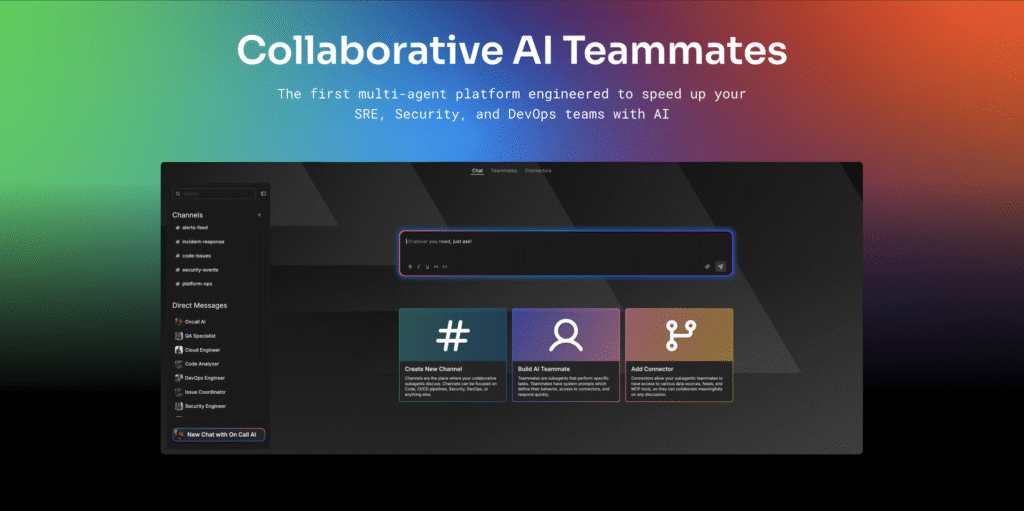I’m writing to you as both a fellow engineer and as the founder of Edge Delta. Today, I’m thrilled to share the largest product release in our company’s history, a milestone that marks a big step forward for AI’s usefulness within businesses. We are entering a new era of human–AI collaboration, one where AI is no longer just a passive helper but an active partner on our teams. Let me tell you why this is such a big deal, and how we got here.
The Data Challenge That Sparked a Revolution
Nearly a decade ago, I realized that the explosion of data volumes was poised to outpace our ability to analyze it by brute force. The world is awash in data; global data is already exceeding 200 zettabytes today. Every server log, application trace, metric, and security event adds to this flood. The rise of IoT and distributed systems means data is not only growing in quantity but arriving faster than ever, prompting a radical shift in how we must handle it. Traditional, centralized approaches — shipping all your logs and telemetry to a single cloud or database and “searching the haystack” — simply can’t keep up at petabyte scale. The pain is familiar: skyrocketing costs, dropped data, and missed insights hidden in the noise.
This insight drove me to challenge the status quo of observability and security. My experiences at Microsoft and Sumo Logic taught me that centralized monitoring models don’t scale in this new reality. The solution was to push intelligence to the data source itself. That’s why we built Edge Delta’s intelligent telemetry pipelines in the first place. What started as a once-niche idea — telemetry pipelines — is now considered critical infrastructure for modern engineering.
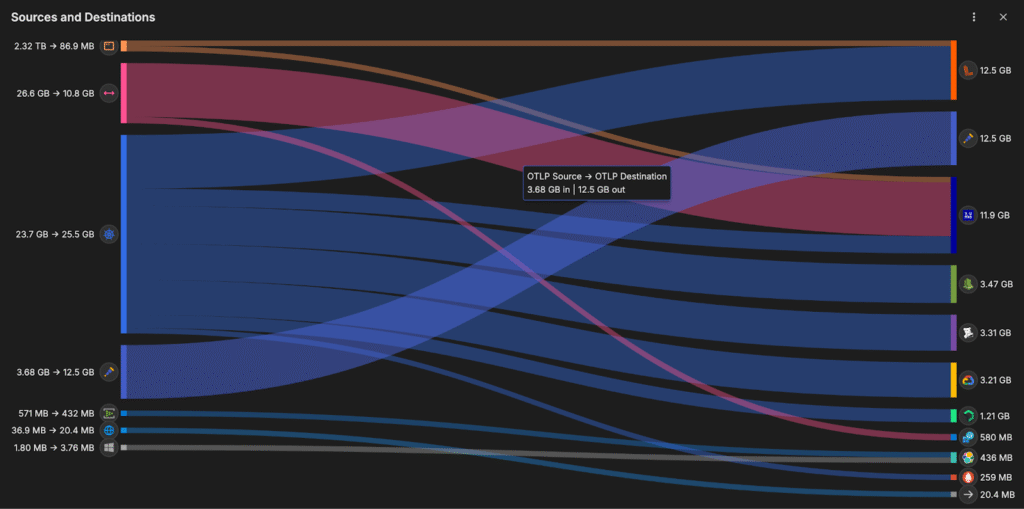
These pipelines analyze and filter data starting at the edge, capturing the important patterns without flooding your network or tools with raw noise. Originally, we designed them for two main use cases:
- Optimized Observability: Our pipelines pre-process and route telemetry data to premium monitoring tools like Splunk, Datadog, Dynatrace, Elastic, Grafana, and others, ensuring you see anomalies and trends without overwhelming those systems. This means you get better insights with a fraction of the data volume, noise, and cost.
- Efficient Archival: We also make sure all your data (even the raw stuff) can be reliably stored in low-cost object storage like AWS S3 or Azure Blob. You keep a full, compliant history without breaking the bank, and you can always retrieve details when needed for audits or deep forensics.
By distributing analysis and doing the heavy lifting before data leaves its source, these pipelines gave teams back control. We could handle petabytes per day in logs and metrics, but forward only what mattered. This foundation helped dozens of companies tame their data firehose and trust that nothing important would slip through.
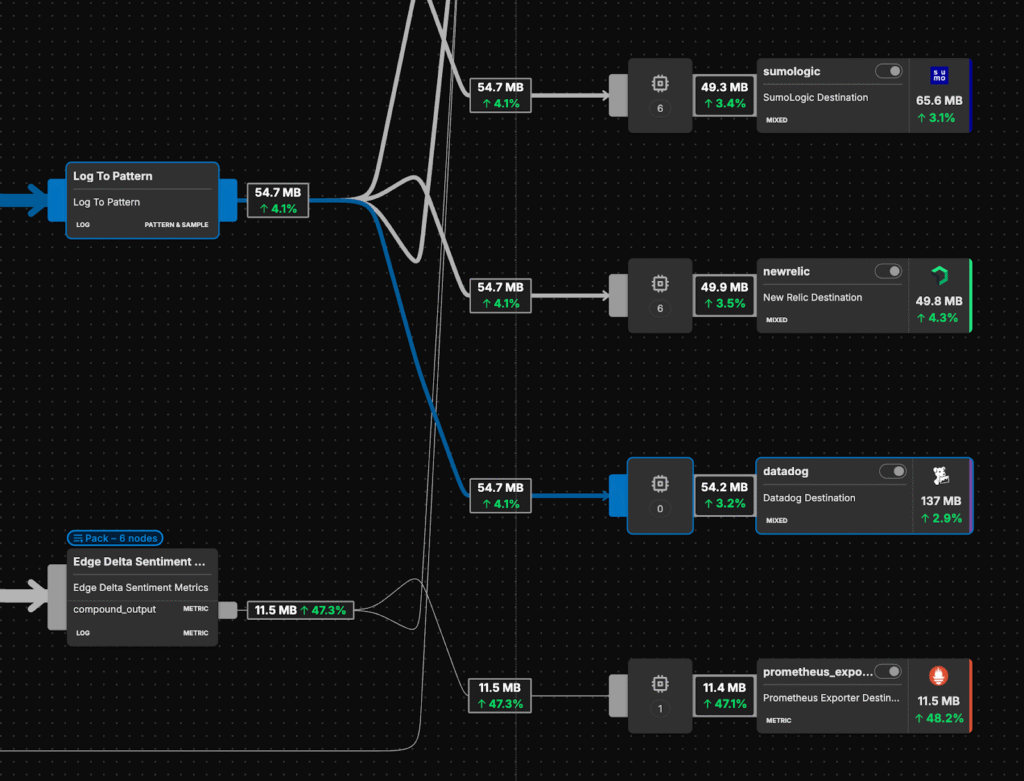
However, optimizing data for people and dashboards was only the beginning. Over the last couple years, one question we always asked ourselves over and over was: What do these pipelines become in the era of AI? Were we really going to force our users in the code GenAI future to manually derive the regex/CEL/OTTL/JS/rules when they never wrote the code in the first place? So that thought grew louder: What if we could automate the optimization and availability of this data for AI as well? After all, even our best analysts struggle to keep up with the large context. In the AI future, if we can effectively feed the highest value information to these models, the limit is exceptionally high.
From Observability to Collaboration: A New Use Case Emerges
Until now, AI in our industry has mostly played the part of a “passive copilot.” Useful, yes, but only when explicitly asked or directed. In coding and knowledge work, we’ve seen AI copilots that suggest code or summarize text. Yet in the operational world of DevOps, SRE, and security, AI has largely been reactive and isolated. It sits on the sidelines, waiting for a prompt, disconnected from the real-time events happening in our systems. Even Microsoft recently acknowledged that AI has “largely been a personal assistant,” not truly a collaborative team member.
At Edge Delta, we envisioned something more powerful: what if AI could become an active teammate, continuously working alongside us? What if it could tap into the real-time streams of data that we deal with — deployment events, log anomalies, security alerts — and help us make decisions faster and more confidently?
This idea led to a third major use case for our telemetry pipelines: feeding intelligent AI workflows. We realized our pipelines could serve as the secure, scalable highways that connect live enterprise data to AI in a safe and controlled way. This would allow AI not just to analyze static datasets or chat about general knowledge, but to plug into live systems, watch events as they happen, and take initiative (under human guidance). In other words, it enables AI that’s not just in the loop, but for the loop, actively helping the humans it serves.
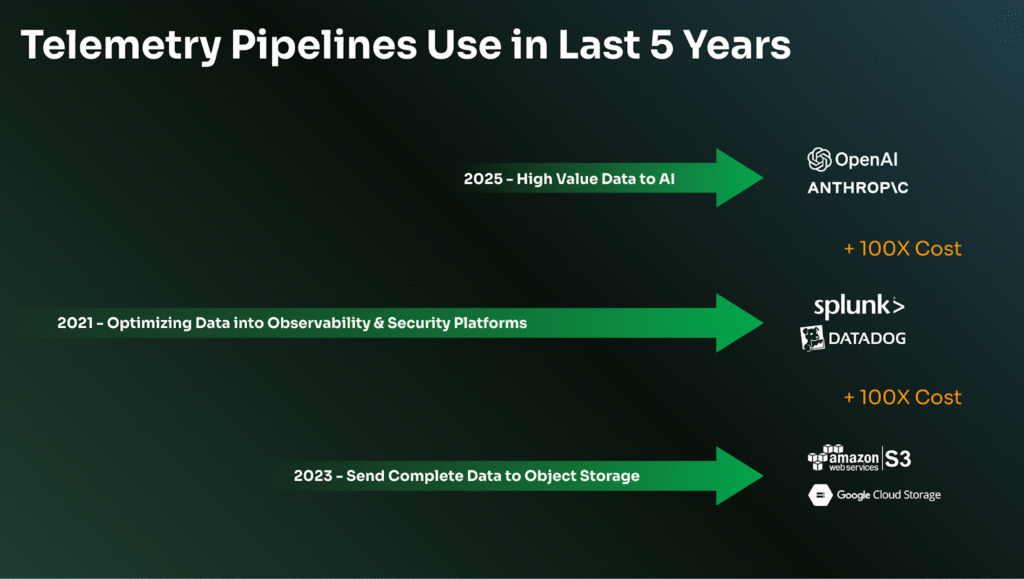
Meet Collaborative AI Teammates
Today, I am excited to introduce Collaborative AI Teammates, the world’s first multi-agent AI platform inclusive of real-time streaming data. This is AI as a true collaborator, not just an assistant you summon. We built, iterated, and optimized this product to solve one of the biggest limitations in AI today: achieving valuable inference on high-throughput machine data. In plain terms, making AI useful in the tsunami of logs, metrics, and events that modern systems generate.
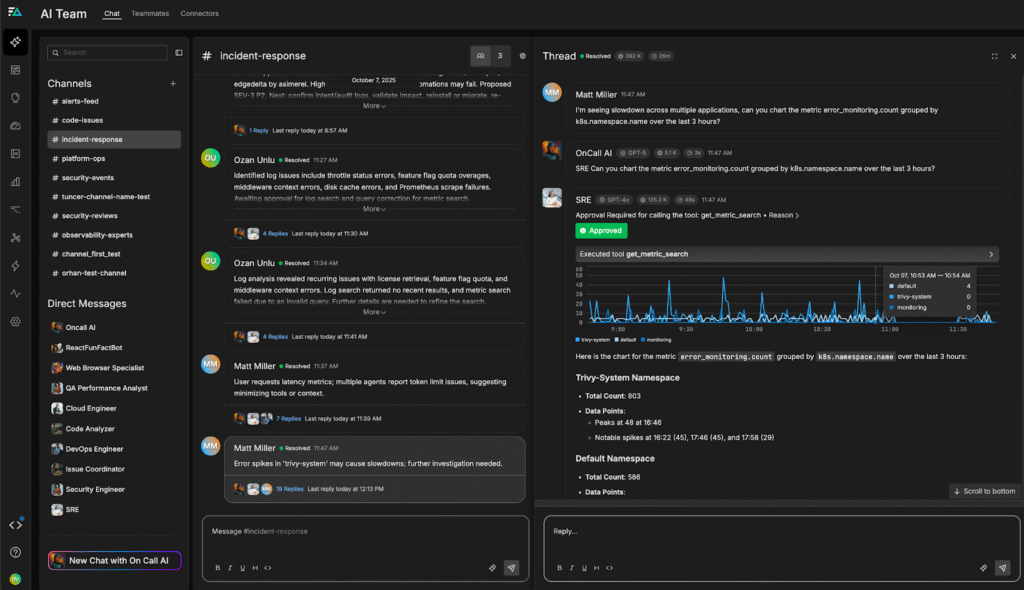
AI Teammates are a network of specialized AI agents that can ingest and analyze data streams in real time, collaborate with each other, and interact with your team. Unlike a single chatbot or alerting script, these agents have different areas of expertise (for example: deployment monitoring, performance anomalies, security threats, etc.) and they communicate among themselves and with you. Their mission is to surface the right insights at the right moment and even coordinate next steps, so that you and your team can respond with speed and precision in critical situations.
Let me explain how this works and why it’s the future:
- Proactive and Always-On: AI Teammates aren’t reactive assistants you have to manually command — they’re proactively watching your systems, 24/7. They’re effectively orchestrated and always on-call, tirelessly scanning for patterns and issues. Most AI agents today lack real-time awareness and only know what you explicitly tell them; in contrast, our Teammates live in the data stream and continuously maintain context. They can catch the early warning signs that would be hard for a human to notice amid millions of events.
- Collaborative Multi-Agent Workflow: These agents talk to each other. If one agent observing deployment logs notices something odd (say, a spike in error rates after a new release), it can alert another agent that specializes in error diagnostics. They will start a discussion, sharing information and hypotheses, and together draw a more complete picture of what’s happening. This coordination accelerates the decision process dramatically. Instead of a single agent giving a single answer, you have a team of agents each contributing their insight, much like how your DevOps and SecOps teams collaborate across specializations.
- Human-in-the-Loop by Design: Crucially, these AI Teammates are collaborators for you, not replacements. We designed the system to make the human-in-the-loop faster and more informed than ever, not to remove the human. In any high-stakes scenario — be it deploying to production or investigating a security incident — critical actions will always require a human decision. The difference now is you won’t be alone in the moment. Imagine having a set of expert assistants who have already sifted through the logs, identified likely root causes, and suggested remedial actions before you even arrive. That’s what AI Teammates enable. They’ll highlight issues and propose solutions before they become major problems, but you make the final call. This preserves control and oversight, which is essential for trust.
- Real-Time Context and Historical Memory: Thanks to our underlying pipelines, each AI agent is grounded in fresh, streaming data as well as historical context. One of the biggest issues with standard AI models is that they’re trained on stale, static data – making them outdated the moment they’re deployed. They often hallucinate or miss nuances because they don’t have live info. Our platform closes that gap. Without a continuous feed of fresh, proprietary data, public LLMs tend to hallucinate or give irrelevant answers; they won’t reflect today’s outage or this hour’s spike unless connected to a streaming pipeline. Collaborative AI Teammates are directly hooked into your event streams, so they always operate on the latest and most relevant information. They retain memory of past events (augmented by access to static data sets and logs in your data lake) to provide context-aware insights. This means fewer false alarms and more accurate, reliable intelligence when you need it.
- Solving the Data Overload for AI: Perhaps most importantly, this platform overcomes the “firehose” problem for AI. You might wonder, how can AI possibly digest all of our data in real time? The answer lies in the same principle that made our pipelines successful: analyzing data at scale, then curating the important nuggets. Some of our customers generate petabytes of raw data per day, and obviously nobody is shipping petabytes into an AI model – it would be astronomically expensive and slow. Instead, our AI Teammates leverage Edge Delta’s continuous curation approach. They comb through the firehose, identify the kilobytes or megabytes of truly significant signals hidden in those petabytes, and focus their AI inference on that. This way, we achieve valuable AI-driven insights on data volumes that would otherwise be impossible to handle. It’s like having an automated system of sifters and detectives: the first layers (our edge processing) boil data down to what matters, and the AI agents then analyze and reason on that distilled information. The end result is actionable insight at machine speed, without drowning in noise or incurring ruinous costs.
Why This Is a Big Step Forward for Every Engineer
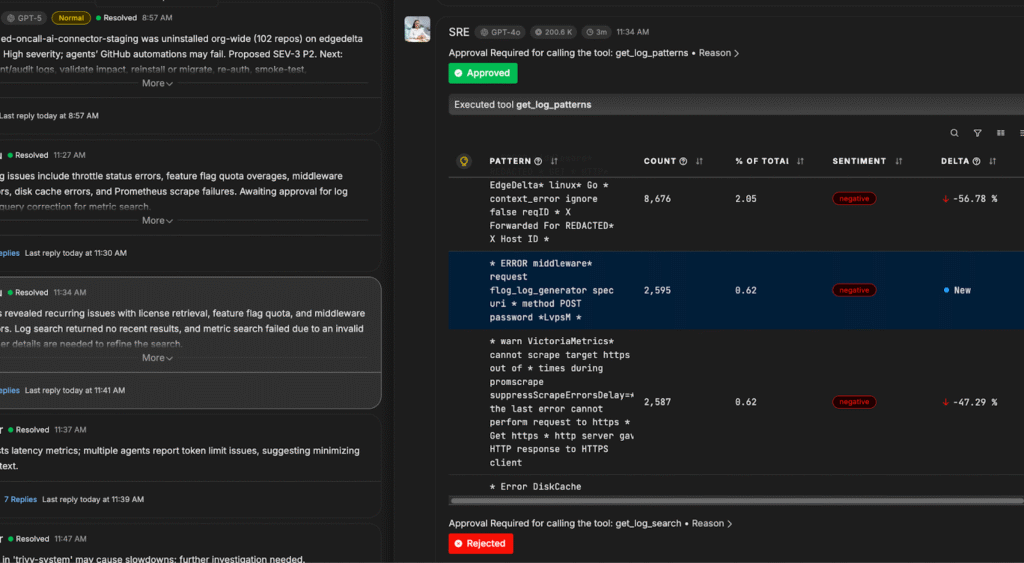
For engineers in DevOps, SRE, observability, IT operations, and security, Collaborative AI Teammates represent a profound shift in what AI can do for you. We’re moving from a world where AI just augments individual tasks, to one where AI can amplify your entire team’s capabilities. Here’s what you can expect:
- Faster Incident Response: Whether it’s a failed deployment, a bug in production, or a sudden spike in errors, your AI Teammates are already on the case. They will detect anomalies or failure patterns in seconds, and initiate an investigation thread among themselves. And by the time you get an alert, it comes with rich context — the likely root cause, impacted services, and recommended actions — assembled collaboratively by specialized agents. This turns “panic moments” into more manageable problems. Teams can address incidents faster, reducing downtime and user impact dramatically.
- Preventive Problem Solving: Beyond reacting to issues, AI Teammates help you prevent incidents in the first place. Because they’re continuously analyzing trends and system behavior, they can flag early warning signs (like gradually increasing error rates, or subtle indicators of a brewing security threat) that might be overlooked. Think of it as having specialized AI agents continuously triaging and watching your back. For example, an AI security analyst agent might catch an unusual login pattern and alert a DevOps agent to tighten a configuration before a breach happens. This kind of preventive insight can save companies from costly outages or security incidents.
- Empowered Human Teams: Perhaps counterintuitively, adding AI teammates makes the human teams even more valuable. By handling the heavy lifting of data crunching and first-pass analysis, the AI frees you to focus on strategic decision-making and creative solutions. Instead of spending hours parsing logs or dashboards, you can spend minutes reviewing the AI’s findings and then use your expertise to make the final call or innovative fixes. This elevates the role of engineers from reactive firefighters to proactive strategists. And because the AI provides explanations and shares its reasoning (the investigation context), it also serves as a continuous training tool – your team gains deeper understanding of systems through the AI’s eyes. It’s a virtuous cycle of learning and improvement.
- Consistency and Always-Available Expertise: Every team has its rockstar troubleshooters – the go-to people for outages or complex bugs – but they can’t be everywhere at once or awake 24/7. AI Teammates encapsulate a lot of that expertise and make it “always on.” They follow best practices every time, they don’t get tired, and they can scale out to watch all parts of your stack simultaneously. This democratizes expertise and serves as a force multiplier for your organization. Your junior engineers now have a safety net and a guide; your senior engineers can offload routine diagnostics and focus on big-picture improvements.
- Cross-Silo Collaboration: In many companies, DevOps, SRE, and Security teams are separate silos that must coordinate during incidents. AI Teammates, however, are inclusively designed for all these domains. They can bridge silos by sharing insights across domains instantly. For instance, a security anomaly agent can inform an observability agent about a spike in firewall denials, which might correlate with an app’s error spike – connecting dots that two separate teams might take much longer to communicate. In this way, AI Teammates act as a communication fabric as much as an analytical tool, ensuring nothing slips through the cracks between teams.
In short, Collaborative AI Teammates augment the capabilities of every engineer on the team, creating a whole that’s greater than the sum of its parts. This is a shift toward truly collaborative AI in the workplace, and it couldn’t be more timely. With so much complexity in modern systems, having AI colleagues to shoulder the burden is not just a nice-to-have – it’s becoming essential.
Built on a Foundation You Can Trust (Enterprise-Grade at Petabyte Scale)
You might be wondering, how can we integrate AI agents so deeply into our operations safely and securely? The answer is: we built Collaborative AI Teammates on top of Edge Delta’s enterprise-grade telemetry pipelines – the same foundation trusted by Fortune 1000 companies for their observability and security data needs. These pipelines are the guardrails that handle everything from permissions and access control to data security, governance, and compliance. In fact, the Edge Delta platform includes built-in encryption (in transit and at rest), audit logging, and robust role-based access control (RBAC) for all data flows. We’re proud to be SOC 2 Type II with years of successful audits and attestations, and our pipelines have been designed from day one to support strict internal governance and privacy requirements.
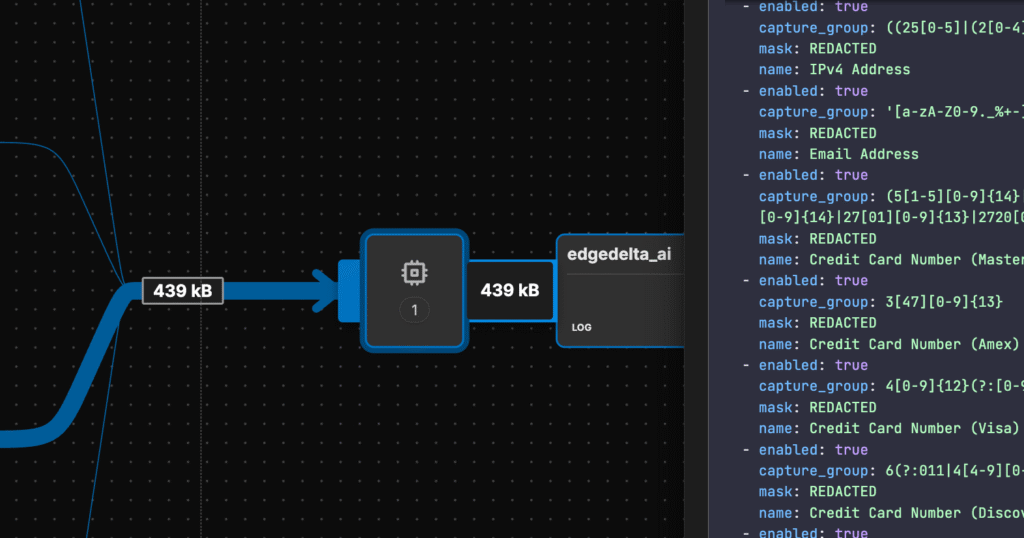
What does this mean for our new AI Teammates? It means they inherit all these protections and policies. Your sensitive log data isn’t blindly fed into some black-box AI in the cloud. Instead, our agents run within the secure confines of the pipeline infrastructure. They only see the data they’re permitted to see, and all their actions are auditable. Moreover, our pipelines can mask or redact sensitive information before it ever reaches an AI agent, ensuring compliance with regulations like GDPR and HIPAA (a capability we’ve long provided to customers to protect PII in logs).

This secure-by-design approach gives you the benefits of advanced AI without compromising on control. You decide where AI Teammates are deployed – whether on-premises, in your VPC, or in our managed cloud – and you set the rules for what they can access or do. The system honors all existing data retention policies and access controls. In short, you get trusted AI at petabyte scale, not a wildcard risk.
Another key aspect is scale. We know enterprise data can be massive and high-velocity. The only reason we can offer real-time multi-agent AI on streaming data is because of the years we’ve spent optimizing these pipelines for throughput and reliability. Edge Delta’s architecture was built to handle millions of events per second across decentralized nodes, performing statistical analysis and anomaly detection in-stream. This same architecture now empowers the AI Teammates. It means as your data grows, your AI’s capacity to handle it grows too – without a linear increase in costs or latency. And since the heavy data crunching happens at the edge (close to the data source), the overall solution remains scalable and cost-efficient. You’re not shipping every raw log to an AI model (which would be unsustainably expensive); you’re leveraging our curated approach to send only what’s necessary for inference, as discussed earlier.
With this launch, Edge Delta becomes the only platform that enables multi-agent AI collaboration across all your data – batched, static, event, and streaming – under one roof. Some solutions out there can handle static knowledge bases, others handle real-time events in isolation, but none (until now) bring it all together with a unified approach. We’ve made it possible to correlate a static dataset (like a config file or an APM trace from last week) with a live streaming event (like a sudden CPU spike in a container) within the AI’s reasoning process. Everything comes together so the AI Teammates have full context. This is unprecedented and is only achievable because of the comprehensive data fabric our telemetry pipelines provide beneath the hood.
Embracing a Collaborative Future
In closing, I want to emphasize why I’m personally so excited about Collaborative AI Teammates. This isn’t just a new product for us – it’s the realization of a vision that’s been taking shape for close to a decade. We believe the future of AI in business is collaborative. It’s not AI vs. human, or AI in a silo, but rather AI working with humans as part of the team. By making AI more agentic, contextual, and trustworthy, we give you the ability to make faster and smarter decisions with confidence. You’ll have the freedom to focus on the high-level strategy and creative problem-solving that matter most to your business, while your AI partners handle the busywork and vigilance at machine speed.
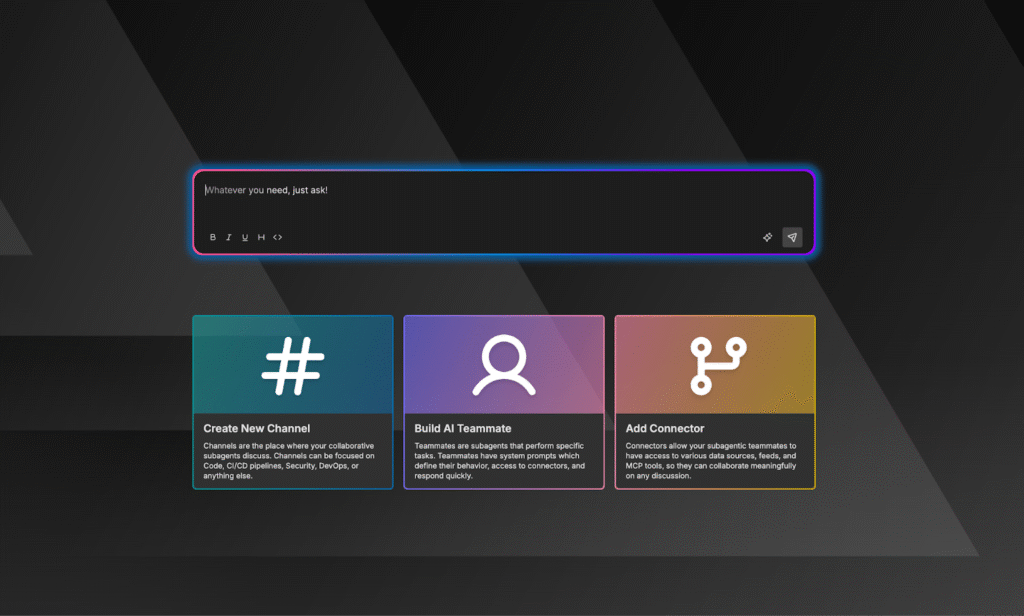
Just imagine: in the near future, every engineering team, every NOC, every security operations center could have a few digital teammates working alongside the human ones. They will continuously share knowledge, watch for issues, and propose improvements. Your on-call rotation might include AI agents that never sleep, ensuring that even at 3 a.m., when an alert fires, an initial triage and context-gathering has already been done by the time the human engineer’s phone buzzes. This isn’t science fiction – with Edge Delta, this is the reality we are delivering today.
The era of passive AI assistants is ending. The era of collaborative AI teammates is beginning. We’re proud to be at the forefront of this transformation. The technology we’re unveiling combines the best of both worlds: cutting-edge AI capabilities and the transparent, proven, scalable data engineering that enterprises require. It’s visionary and innovative, but also grounded in the practical needs and technical truths of our industry.
To our community of engineers and leaders: I invite you to join us on this journey. The future is here, and it’s collaborative. Let’s embrace this future where humans and AI together drive our businesses to new heights of performance, reliability, and intelligence. I truly believe that years from now, we’ll look back and wonder how we ever managed operations without AI teammates by our side.
Thank you for your time, and as always, thank you for inspiring us to push the boundaries. I’m incredibly excited for you to experience what Collaborative AI Teammates can do. This is just the beginning of a new chapter, and we’re writing it together.
—Ozan

